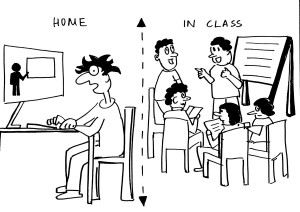Flipped classroom signifies progressive shift
When most people picture a college lecture course, they see a crowded, auditorium-style room with a professor speaking to hundreds of students. For decades, this image has represented a traditional university class, but select educators at Harvey Mudd College believe it’s time for a change.
Professors Darryl Yong, Rachel Levy, Karl Haushalter and Nancy Lape are currently researching the effect of “flipped” classes. In these classes, students watch their professor’s lectures online, instead of in a lecture hall. They then attend discussions or group exercises closely based on the lecture material and are encouraged to email professors with any questions they have prior to discussion sections.
Though online lectures are flexible with students’ schedules, discussions ensure that students don’t forego invaluable collaboration with professors and classmates. Some discussion sections include quizzes on the online video to ensure student viewership.
If these online lectures are more effective than traditional lectures, they could be precisely the shake-up higher education needs. Technology is improving all other aspects of daily life, so why not education?
Gone are the days of jam-packed lecture halls filled with eager, attentive pupils. Instead, students frequently skip lectures, and those who do attend often do so while multitasking on their laptops — finishing other assignments, sending emails and checking social media. This produces an environment that is more study hall than lecture hall.
So far, the results from Harvey Mudd’s research seem promising. Professors tested flipped courses by splitting their classes into two groups. One group attended traditional lectures while the other watched lecture videos from the same professor online. Results of the ongoing study have shown no perceptible difference in performance between the two groups, proving that flipped classes could represent a viable replacement to traditional lectures.
These results aren’t surprising, considering the fact that most students are already learning from the Internet. Students frequently supplement, if not replace, their in-class learning with free information available to them online. SparkNotes and Wikipedia are the newest humanities professors, and Khan Academy, with over 10 million users, is the 24/7 math professor. With all of these free alternative options, universities must establish their own online educational presence or face the consequence of students tuning out professors in the classroom, only to tune in to someone else on their laptops.
As student loan debt rises and universities face increasing criticism for unaffordability, the last thing administrations want is for students to wonder if their investment is worth it. Yet, when students are paying to attend a university but learning from other sources, this is exactly the question that arises. Researchers also believe flipped classes could decrease the costs of a higher education, a definite benefit.
This combination of new technology and new options has spurred a “Space Race” of education, as schools rush to find innovative ways to compete with online learning sources. Villanova University, the University of South Florida and North Carolina State are also testing flipped courses. USC could benefit from joining this race and offering undergraduate students similar online options.
Investing more resources in utilizing technology would not only help USC remain relevant — it would help students get more out of their education.
The phrase “full-time student” is nearly obsolete, especially at USC. Though at one time attending lectures might have been students’ first and only priority, it’s a different story today. USC encourages a wide range of interests, a push toward diversity that students embrace through a broad range of activities, from sports to clubs to internships. It’s very rare to find someone who names “going to class” as their sole activity.
Flipped classes alleviate the craziness of the modern college student’s schedule by allowing students to “attend” lecture when it best fits into their schedules, instead of arranging their schedules around lecture times. And if they’re struggling with a topic, students can replay lectures as many times as they want.
Our generation is known for our attachment to instant gratification, and critics might claim that altering education so students can access lectures when they want is another example of this. But current methods aren’t set in stone, and there’s no reason not to update education in accordance with shifting technology and culture. Most would agree that our current system of higher education isn’t perfect, especially with the debates over the value of college.
The question of whether college is “worth it” simply shouldn’t be a question. Universities can combat this concern by offering students as many services as possible, and if this means flexible, online lectures, then so be it.
Even if flipped classes don’t catch on, it’s obvious that in light of available technology, shifting student priorities and the ever-present pressure to lower costs, higher education is about to undergo a major change. As a leading university, USC should be at the forefront of this shift.


